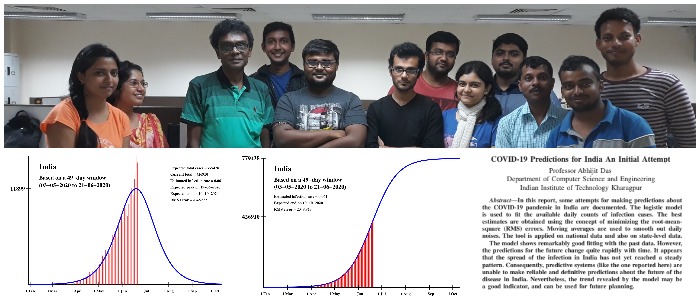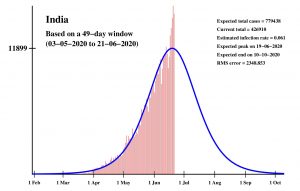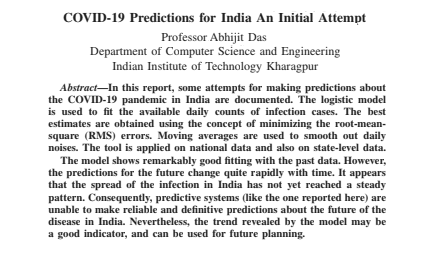The study also predicts that new cases of the disease will continue until at least the end of September 2020.

India Today Hindustan Times Times of India Economic Times (Health) Business Insider News 18 Outlook The New Indian Express Down to Earth NDTV The Hindu India Blooms Telangana Today Lokmat Navbharat Times Dainik Jagran
IIT Kharagpur has developed a prediction system to help predict the future spread of COVID-19 and help decision making in health-care, industry, economy, and even academics. Prof. Abhijit Das from the Dept. of Computer Science and Engineering has developed a logistic model which can be used to fit the available daily counts of infection cases.
The data used for the predictions pertain to the entire country, and for the eight most affected states in the country including Maharashtra, Tamil Nadu, Delhi, Gujarat, Uttar Pradesh, Rajasthan, West Bengal, and Madhya Pradesh.
Talking about the model development Prof. Das said, “The model uses only the daily infection counts available in the public domain without accessing sensitive information pertaining to medical records or contact-tracing data for a large fraction of the population. Despite that, the prediction curves show remarkably good fitting with the past data, and can be used for future planning.”
Prof. Virendra Kumar Tewari, Director IIT Kharagpur said, “People have been living in an uncertain black box without the knowledge about which way life is going to turn and how to plan their activities. A study like this based on a clear statistical model will enable them to understand and plan their wayforward. The model though experimental could prove to be helpful in planning our academic semester and policy matters related to the Institute and the campus under the current circumstances.”


However, the predictions for the future change quite rapidly with time. There are several potential factors for this such as different mobility patterns of Indian people in different phases of lockdown, large-scale migration of laborers, change in diagnostic facilities, evolution of the coronavirus, and so on. These are well beyond the control of the logistic model or any other currently known prediction model for that matter.
Although the implementation fails to generate stable and reliable predictions at the moment, the trend clearly reveals that the disease is going to stay in the country for many more months.
“Our study indicates that India is yet to achieve a steady pattern in the spread of the disease. It is unlikely to get rid of COVID-19 before the end of September 2020,” remarked Prof. Das.
He further added, “This does not leave us in a region of comfort, but the reality has to be accepted, and appropriate plans must be chalked out to address all the issues associated with the outbreak of the pandemic.”
Contacts:
Project Information: abhij@cse.iitkgp.ac.in; Institute Related: Prof. B N Singh, registrar@hijli.iitkgp.ac.in; Media Outreach: Shreyoshi Ghosh, shreyoshi@adm.iitkgp.ac.in; More News:: https://kgpchronicle.iitkgp.ac.in/; Follow IIT Kharagpur on Social Media: Facebook:@IIT.Kgp; Twitter: @IITKgp; Instagram: @iit.kgp




